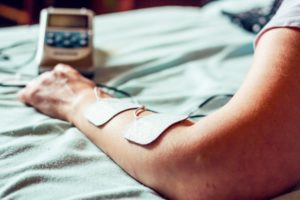What is Electrical Stimulation or E-Stim?
Electrical stimulation (commonly referred to as E-stim) is assistive technology that uses an electrical current to move weak or paralysed muscles. You will feel tingling in your skin and muscles, but it is not painful. Electrodes placed on the skin receive electrical signals from a small unit. This then facilitates the movement of weak or paralysed muscles, which is a common symptom of neurological conditions including Stroke, Cerebral Palsy, Parkinson’s Disease, Multiple Sclerosis and more.
Electrical Stimulation has been used since the 1960’s to help foot-drop and improve walking. More recently, Electrical Stimulation has been used in upper limb rehabilitation, including for stroke patients who have shoulder pain in their weak shoulder.

What does it do?
An Electrical Stimulation machine;
- Facilities movement.
- Encourages contraction of paralysed muscles.
Electrical stimulation may also;
- Strengthen weakened muscles.
- Improve motor control (voluntary movement).
- Improve sensory awareness.
- Reverse changes in the muscle that come as a result of weakness and unused muscles (see more details below).
Muscles are made up of two types of fibres; Type 1 fibres (that don’t generate much force but take a long time to fatigue), and Type 2 muscle fibres (generates lots of force but get tired easily). Muscle weakness and wasting are common in many neurological conditions, and Type 2 Fibres can slowly change to Type 1 Fibres. E-stim may be able to reverse these muscle fibre changes.
How does E Stimulation Work?
A key part of Neurological physiotherapy is based on the brain’s ability to rearrange itself, also known as neuroplasticity (https://scnr.com.au/about/what-is-neurological-physiotherapy/). There is evidence to suggest that Electrical Stimulation may be able to enhance reorganisation of the brain through the movement that E-stim can facilitate.
Many studies have shown positive effects of E-Stimulation, however the studies only looked at small samples sizes. This means we have to be careful to interpret these results, and it may not be effective in the wider population.
What to expect:
- Before placing the electrodes the physiotherapist will need to prepare your skin. This may include wiping away dirt and oils with an alcohol wipe, and may involve removing excess hair.
- The physiotherapist will place electrodes on your skin. These are attached to a small machine.
- The settings on the machine will be adjusted based on which muscles are being stimulated.
- The physiotherapist will turn the machine on and gradually turn it up. You will feel a tingling sensation on your skin. If it is painful, you must tell your physiotherapist.
- You will start to see your muscle moving. The physiotherapist will encourage you to help with the movement.
- There will be an “on time” (when the machine is on and muscle is moving) and a “rest time” when the muscle is resting. The rest time will usually be longer than the on time.
- Sometimes you may not get the movement straight away, and it might take a bit of adjustment to get the electrodes in the right place.
Here at Sunshine Coast Neuro Rehab, our Physiotherapists understand you and your condition. We support people with neurological conditions to achieve more function, greater independence and quality of life. If you are interested to learn more about electrical stimulation, or would like to make an appointment, please make a booking by calling (07) 5448 115 or email admin@scnr.com.au.
Kira Odling, Physiotherapist, APAM
Evidence:
Meilink A, Hemmen B, Seelen H, Kwakkel G. Impact of EMG-triggered neuromuscular stimulation of the wrist and finger extensors of the paretic hand after stroke: a systematic review of the literature. Clinical Rehabilitation 2008; 22: 291-305. http://cre.sagepub.com/content/22/4/291.long
Robertson V, Ward A, Low J, Reed A. 4th ed. Electrotherapy Explained – Principles and Practice. Edinburgh: Butterworth Heinemann Elsevier. 2006.
Gorman PH, Peckham PH, Functional electrical stimulation in neurorehabilitation. In: Selzer ME, Clarke S, Cohen LG, Miller RH editors. Textbook of Neural Repair and Rehabilitation. United Kingdom: Cambridge University Press, 2014, pp. 120-134.
